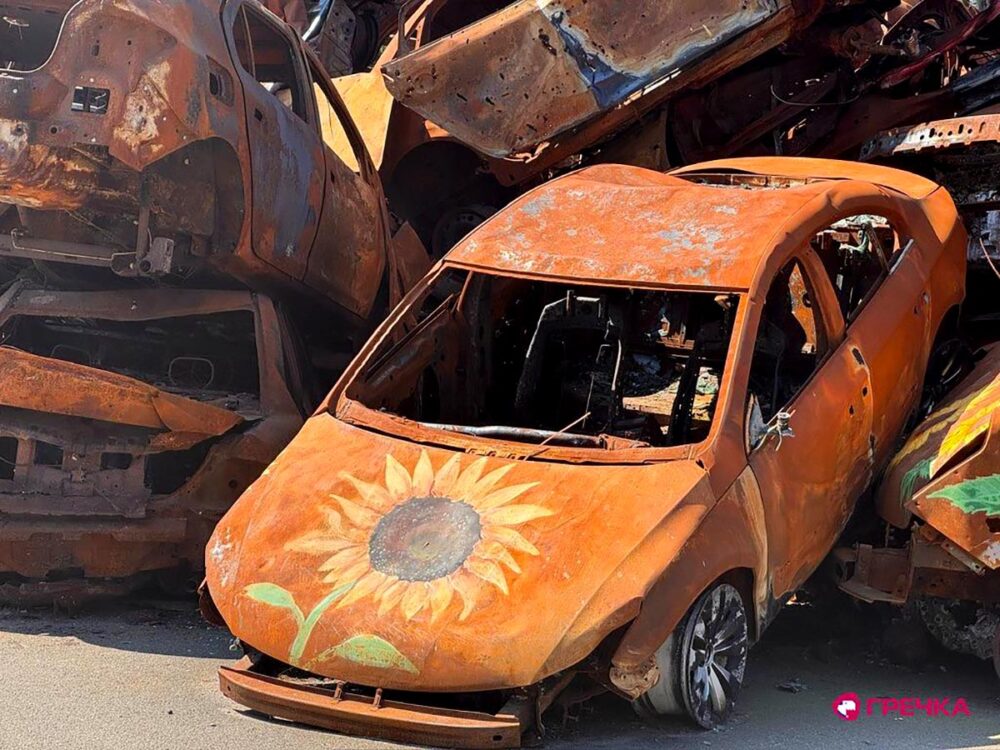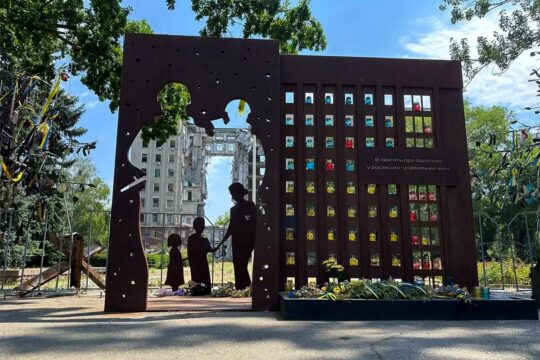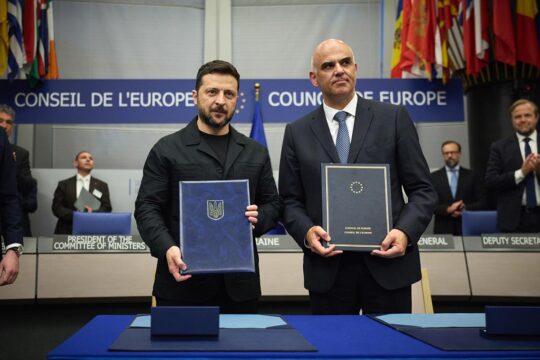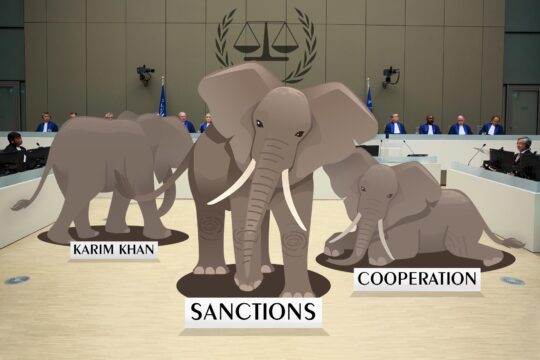A date is engraved in large letters on the plaque – 25 February 2022, the day the bridge was blown up. A new road to Kyiv is roaring nearby, just separated from the destroyed bridge by a noise barrier. The Romanivskyi Bridge can only be visited upon request.
The wrecked bridge, in the first weeks of the Russian full-scale invasion, has become a symbol for the residents of Irpin, Bucha and surrounding towns. The Ukrainian military blew it up to stop Russian columns from advancing on Kyiv, the capital city, less than an hour drive.
At the same time, the bridge became also a gate to salvation. People would leave their cars, cross the river under fire and carry out the wounded.
Today, it is preserved as a memorial. Ceremonies are held here on commemorative days. Foreign delegations and war researchers come here.
A metal structure with a QR code has been installed in front of the precipice of the destroyed bridge. It leads to a website about places of remembrance of the start of the Russian invasion in the Kyiv region.
Irpin, pioneer city for memorialization
Irpin was partially occupied between late February and 28 March 2022. During this period, the city sustained extensive damage, and many residents found themselves caught up in the middle of the hostilities. According to various reports, several hundred people were killed in the city, including civilians, Irpin defenders, and residents of nearby villages.
Today, the city is not only rebuilt but also coming to terms with what it has been through by creating areas of remembrance. This aspect is being handled by the memorialisation department of Irpin City Council, the first officially established division of its kind in Ukraine.
Sofia Martyniuk, an artist, is the head of this project. Born in Irpin, she returned home after the de-occupation, joined volunteer and art initiatives, and later engaged in shaping the municipal remembrance policy.
Our conversation with her explores the ways in which Irpin approaches memorialisation.
Martyniuk explains that the current display of the bridge site was created by the Kyiv regional administration. But the city has a broader vision. Irpin plans to turn this space into a dedicated memorial complex. It will include the bridge, an adjacent park, footpaths and the Romanivskyi culture house, which will become a cultural and tourist centre.
“We want to work with the entire area as a single entity. It should not just be a place of remembrance, but a vibrant neighbourhood – a place where memories are preserved, but where life goes on,” Martyniuk says.
She plans to launch a call for proposals. Architects, ecologists, and engineers will be invited to participate. Their objective will be to find a balance between preservation of authenticity, structural safety, and the river ecosystem. And most importantly, to convey the accurate narrative of this site.
According to Martyniuk, the requirements of the call for proposals should include first and foremost the human dimension of the rescue. When crossing the river, people would pass the threshold between danger and relative safety. Some were walking from occupied villages, others were escaping under fire. And when people would get on the evacuation buses, there would be a moment of ‘relief’ – a brief feeling that they had managed to survive.
Mutual aid was another important aspect. Military personnel, civilians, and volunteers had gathered here. They were coordinating the defence, delivering humanitarian aid, and maintaining communication with Kyiv.
“This place should preserve the authentic atmosphere of that time and allows us to go back to that period and feel what people were going through,” Martyniuk adds.
For example, those who experienced the evacuation recall that the water in the river was freezing cold at the time. To capture this feeling, there is an idea to create an interactive element – an area with water that will remain cold even in hot weather.
This location has its own stories. One is about a car that remains under the bridge. “The story is that on the day after the bridge was blown up, a driver was driving at high speed and fell into the river. The man survived, but the car remained at the bottom of the river,” Martyniuk recounts. “After the de-occupation, he wanted to get it back. But the car was purchased for the sake of keeping everything as it was. It is a reminder of the evacuation chaos.”
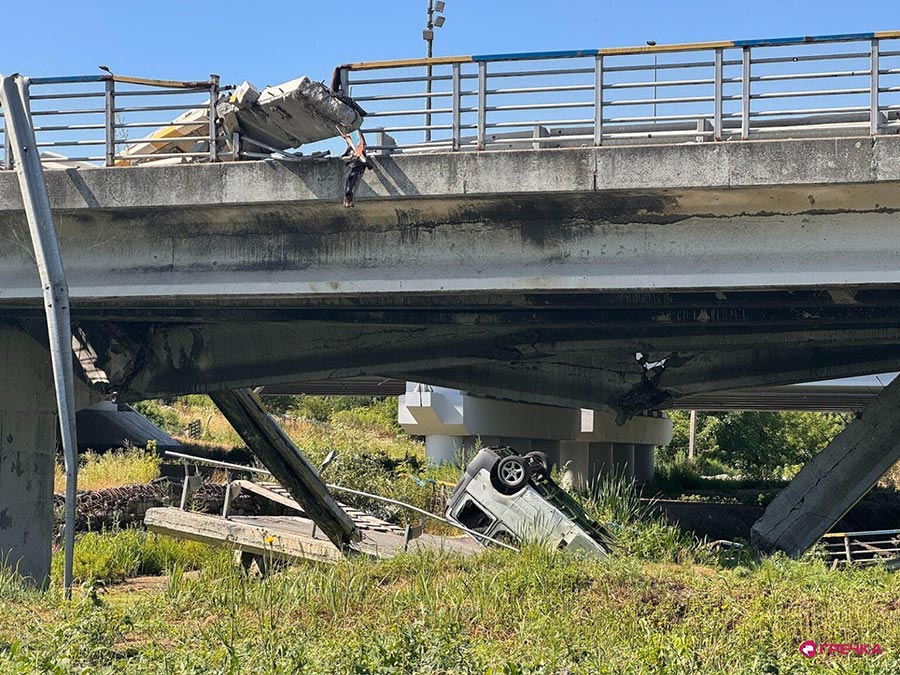
The ‘car cemetery’, a testament to the road of life?
After the liberation of Irpin, while clearing the access roads to the bridge, municipal services would take burned-down vehicles in a place located near the Romanivsky Bridge. Most of them were destroyed by shelling during the evacuation. This is how a space that locals call the ‘car cemetery’ emerged. It is one of the most powerful visual metaphors of war: a pile of burned-down car shells, damaged by explosions, has become a testament to the road of life.
What to do with this place is still an open question. The team of the memorialisation department is considering various options: turning it into a museum or an art installation. According to Martyniuk, the primary objective is to preserve its authenticity: “This place can be cleaned up in a single day. But then, if recreated, it will become somewhat artificial.”
The future site, she adds, should not be part of the city’s everyday life. It should be a place that people consciously choose to visit. The concept suggests a physical separation of the ‘car cemetery’ to avoid constant reminders and residents’ re-traumatisation.
Foreign artists and trauma
A completely different story is about the artistic rush following Banksy’s famous visit to the Kyiv region. Artists from different countries were eager to leave their mark on places that had made global headlines. At that time, a group of foreign artists painted sunflowers and abstract patterns on the shells of burned-dawn cars. Formally, a permission was granted by the city council. But now they admit that there was a lack of professional discussion to evaluate the ethical risks. After all, for many families, these cars represent personal losses.
“It’s a semi-conflict situation,” Martyniuk explains. “Sometimes artists try to earn reputation credits on trauma. But sometimes it’s the opposite: powerful artistic actions, as in Banksy’s case, help the world see something important.”
The Irpin art commission was established to ensure that such initiatives are not random. It includes independent experts – architects, gallery owners, and art critics, and provide recommendations on public projects in the field of culture and memorialisation. The aim is to avoid ethical mistakes and develop a mature approach to working with remembrance.
Culture house and layered drawings
Just like the ‘car cemetery,’ the Irpin Culture house, destroyed by a missile strike, became a canvas for spontaneous artistic experiments after de-occupation. One after another, new layers of drawings would appear on its facades.
The artists who followed Banksy to the Kyiv region first painted large tridents, then sunflowers. Later, black-and-white abstractions appeared with figures that could be interpreted as a headdress, a missile or a bear.
“So much was done in a hurry and without explanation to the community,” Martyniuk says. “Is it appropriate in a city that has endured occupation? Would it make more sense for artists to talk about Irpin and Ukraine from their homes? The context of war is our everyday reality.”
The decision was made not only to rebuild the Culture house, but to preserve it as a witness to the war. Part of the destroyed building with traces of shelling is already ‘preserved’ under a glass dome. As part of the reconstruction, it is planned to keep as much of the authentic brick walls, made at a local brick factory.
A temporary artistic element has appeared next to the ruins – a sculpture by Japanese artist Yoshio Yagi entitled ‘Meditation Space for a Monk.’ It is a courtesy of the Ukrainian art community ‘ChervoneChorne,’ which hosts international sculpture symposiums every year.
In 2023, when museums closed their exhibitions due to the war, the community curator launched a project to bring art back to the people. The sculptures were displayed in the open air in Stryiskyi Park in Lviv. At that time, Martyniuk asked for one of the works to be donated to Irpin.
Yagi’s work symbolises the path to inner peace – the stairs that a monk climbs to reach a place of meditation. In Irpin, it has taken on a new significance: it symbolises the path to recovery. The sculpture was placed right in the crater left by the explosion.
“We kept the crater deliberately,” Martyniuk explains. “It’s also symbolic: through a cultural act, we are reminding people of a destroyed, crippled culture.”
Banksy’s gymnast still dances
Among Irpin’s new memorial sites, Banksy’s work – a girl gymnast balancing on the ruins of a building destroyed by war – has a special place.
The building on which the drawing appeared in 2022 was beyond repair. It was dismantled, and part of the wall was moved. A fragment of the wall with shelling marks was preserved as an installation. Now it is under protective glass. The structure was designed to preserve the context – the hole in the wall that became a ‘ball’ under the gymnast’s feet.
A square with a recreation area is to be created around it. According to Martyniuk, the main idea is to make the place a symbol of resilience and life: “This injured gymnast still dances. We want this place to live on as well.”
The idea is to reinforce Banksy’s original concept. Banksy was awarded the title of honorary citizen of Irpin.
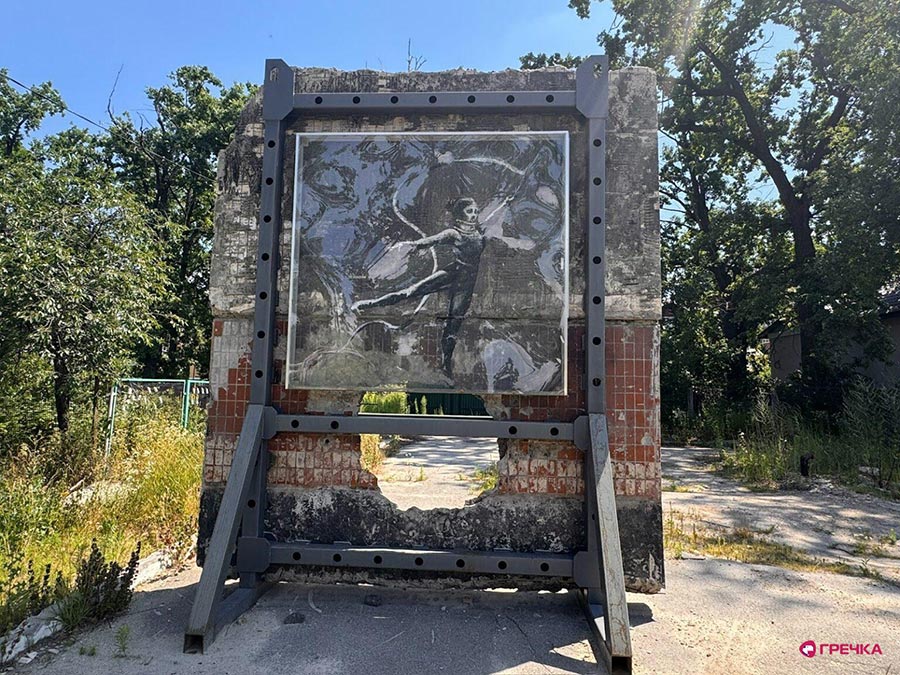
Commemorating sites of resistance
One of the focuses of Martyniuk’s team is the memorialisation of resistance sites in Irpin. Her team is currently meeting with the defenders of each checkpoint to gather testimonies, compare different perspectives, and “create an urban narrative”.
“We record interviews with commanders,” Martyniuk explains. “Many people were involved, and all of them have their own stories. There are those who were at the checkpoint for only five days but speak out vividly. And there are commanders who could see the big picture. After these conversations, I realised that the defence was not chaotic, as it is often believed. They acted in a coordinated manner and maintained contact with intelligence.”
One such important location is the ‘Giraffe’ checkpoint on the border between Irpin and Bucha. It got its name from a nearby supermarket. During the occupation, it was an important defensive position.
“This is a strategic high ground, basically the edge of Irpin,” Martyniuk says. “Bucha starts right after the traffic lights. And this street continues with Vokzalna Street, where a column of Russian military equipment was burned down. It intersects with Yablunska Street, where torture and executions took place.”
Irpin decided to preserve these sites of resistance. Each site will have a QR code with a link to the specific location’s defence story.
The honorary burial sector, symbol of a ‘bright memory’
Along with memorialising civilian casualties, a sector for the honorary burial of military personnel is under development in Irpin. The project began with extensive meetings with the families of the deceased. They were gathered several times for public hearings and open discussions.
“These conversations were difficult. It was hard to explain why all the graves had to be standardised,” Martyniuk recalled. “We also insisted on light colours being predominant in the concept. It symbolises a bright memory. It should be a place for reflection and gratitude, not a depressing space that you would want to escape from. People welcomed this idea.”
The project was approved based on the principle of ‘one family, one vote.’ All gravestones will have the same design – Cossack crosses made of white Spanish granite. Portraits will be depicted on sepia-coloured glass.
The plaques will also have QR codes that will lead to a digital archive about the fallen soldiers. Biographies, photos, and honours will be available for viewing. A ceremonial area and flagpoles with flags of different military forces will be installed within the sector.
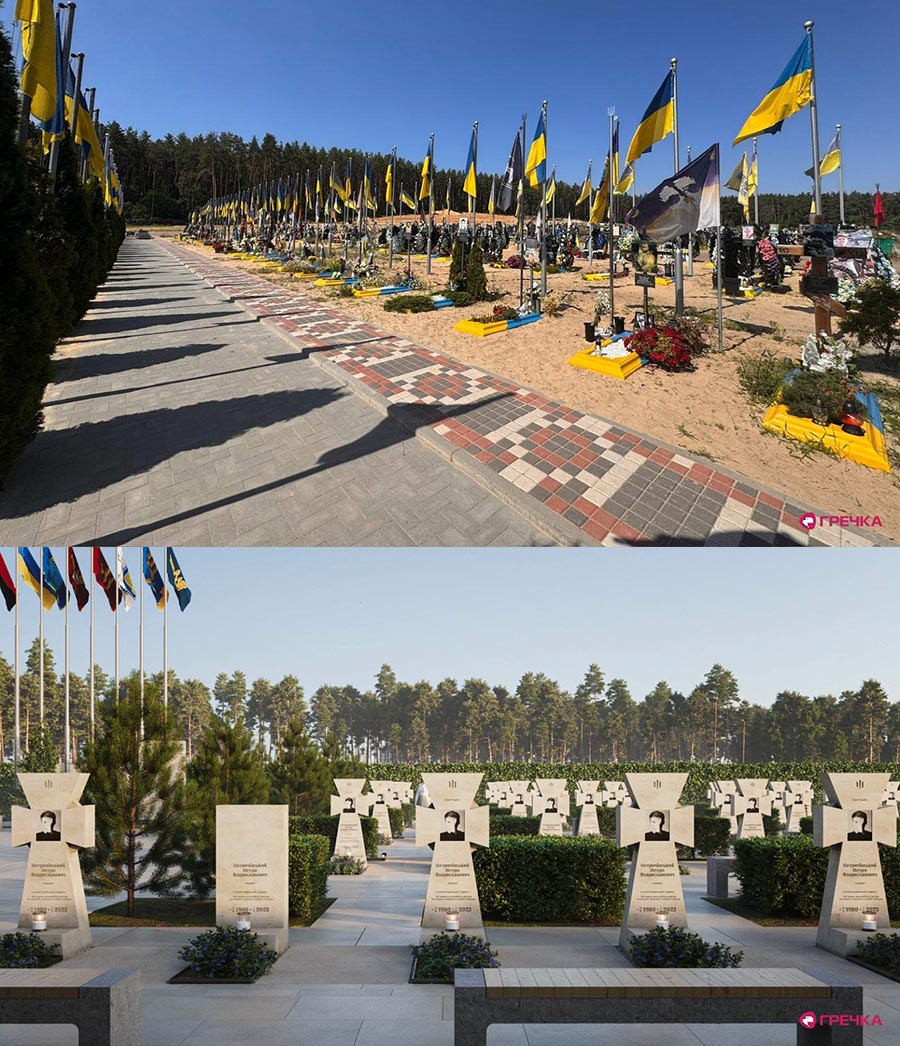
Art, architecture, history and dialogue
In Ukraine, the memory of fallen soldiers is usually commemorated with memorial plaques on the facades of schools or houses where they lived. After the full-scale invasion began, plaques also began to appear at the sites of their deaths. To give these initiatives a unified form, an updated visual concept was developed in Irpin.
One of the first new plaques is in honour of a Belarusian volunteer who died defending the city. It is made of stainless steel and features his portrait, name, call sign, and a QR code that links to the soldier’s story, along with the red and white national flag of Belarus.
Irpin is introducing new approaches to preserving memory. The experience of what the city has gone through is being addressed through art, architecture, history and dialogue. The projects carried out show that memory can be alive, compassionate, and contemporary.
This report was produced thanks to a grant by Fondation Hirondelle/Justice Info. A full version of this article was published on July 23, 2025, in "Gre4ka".


